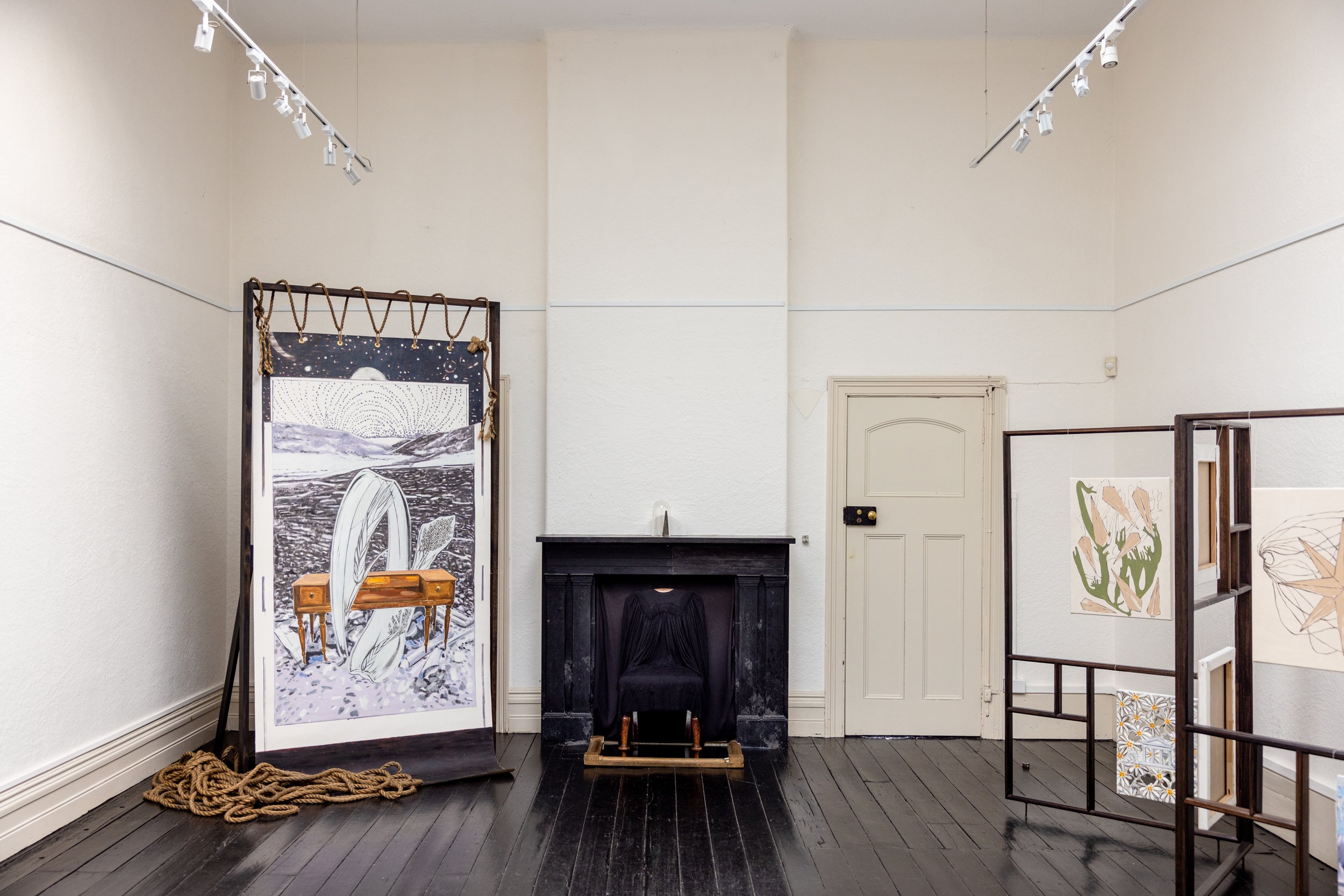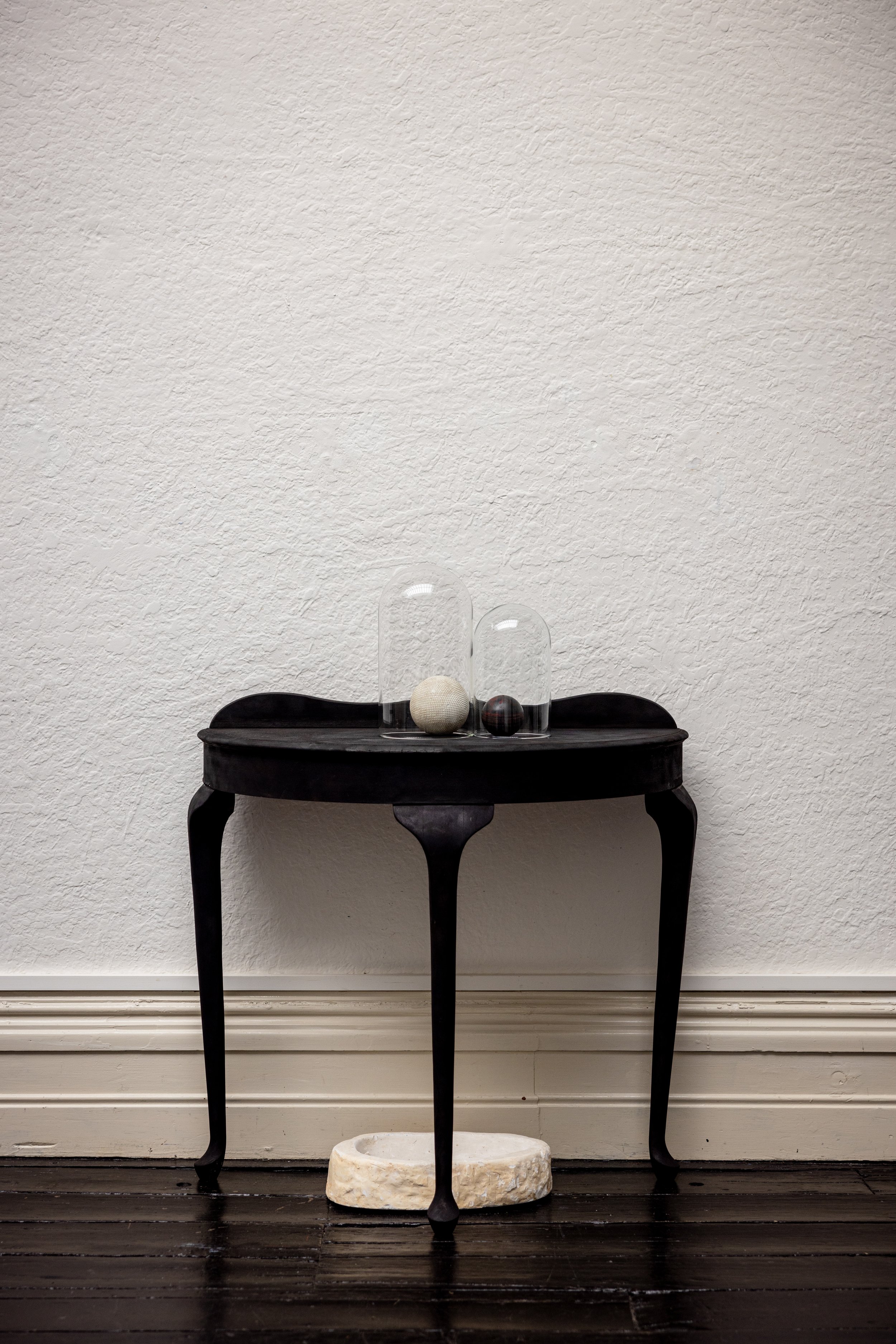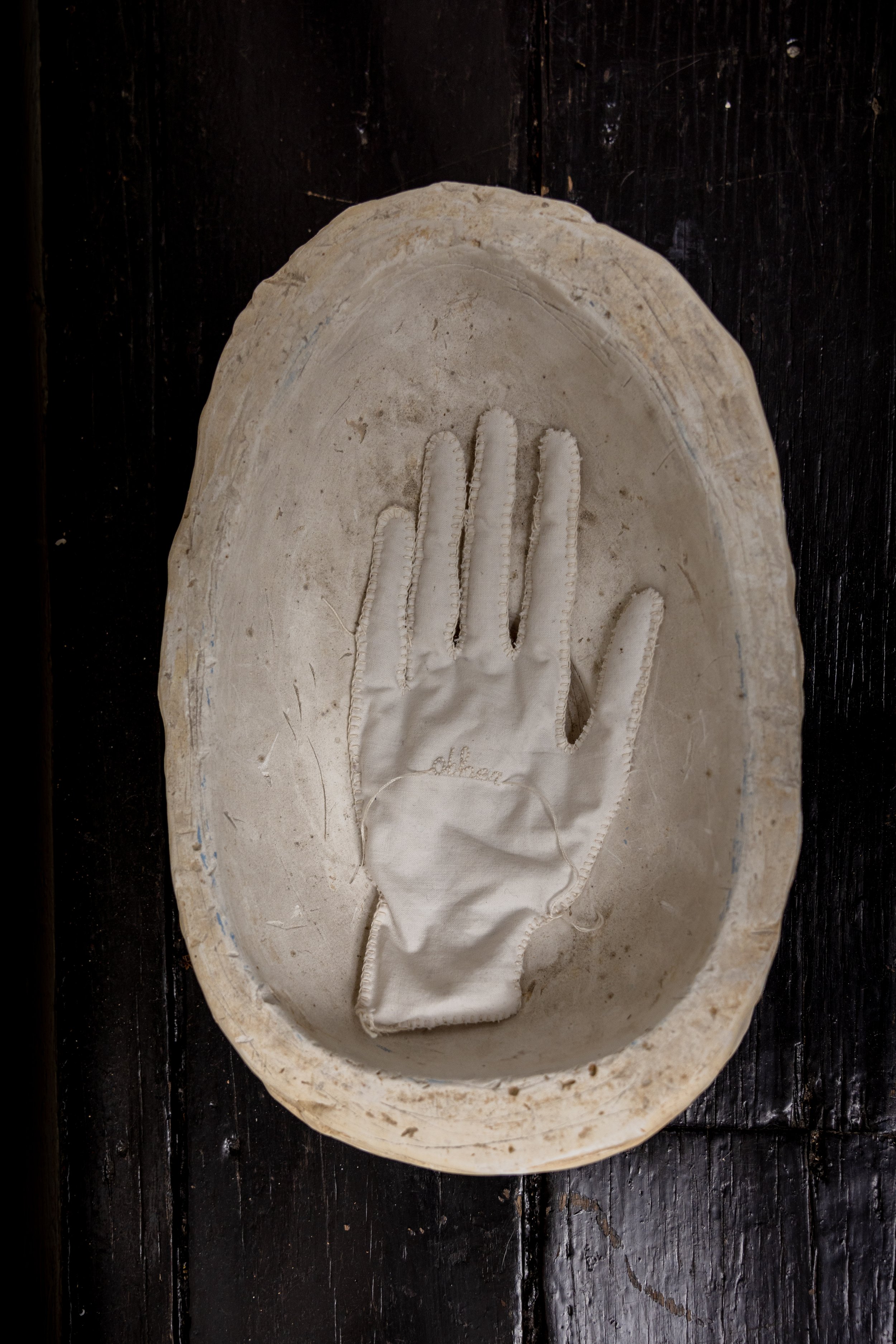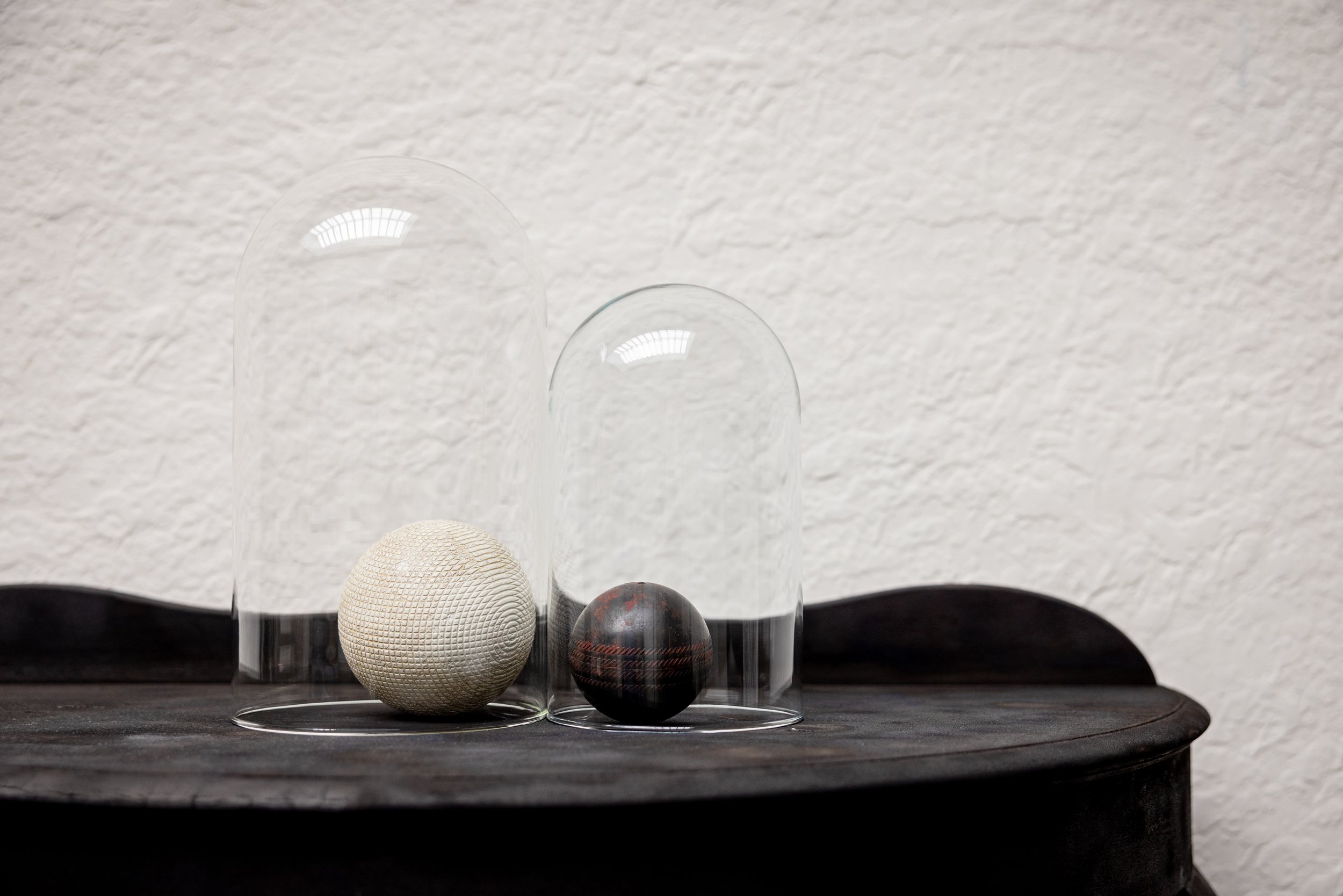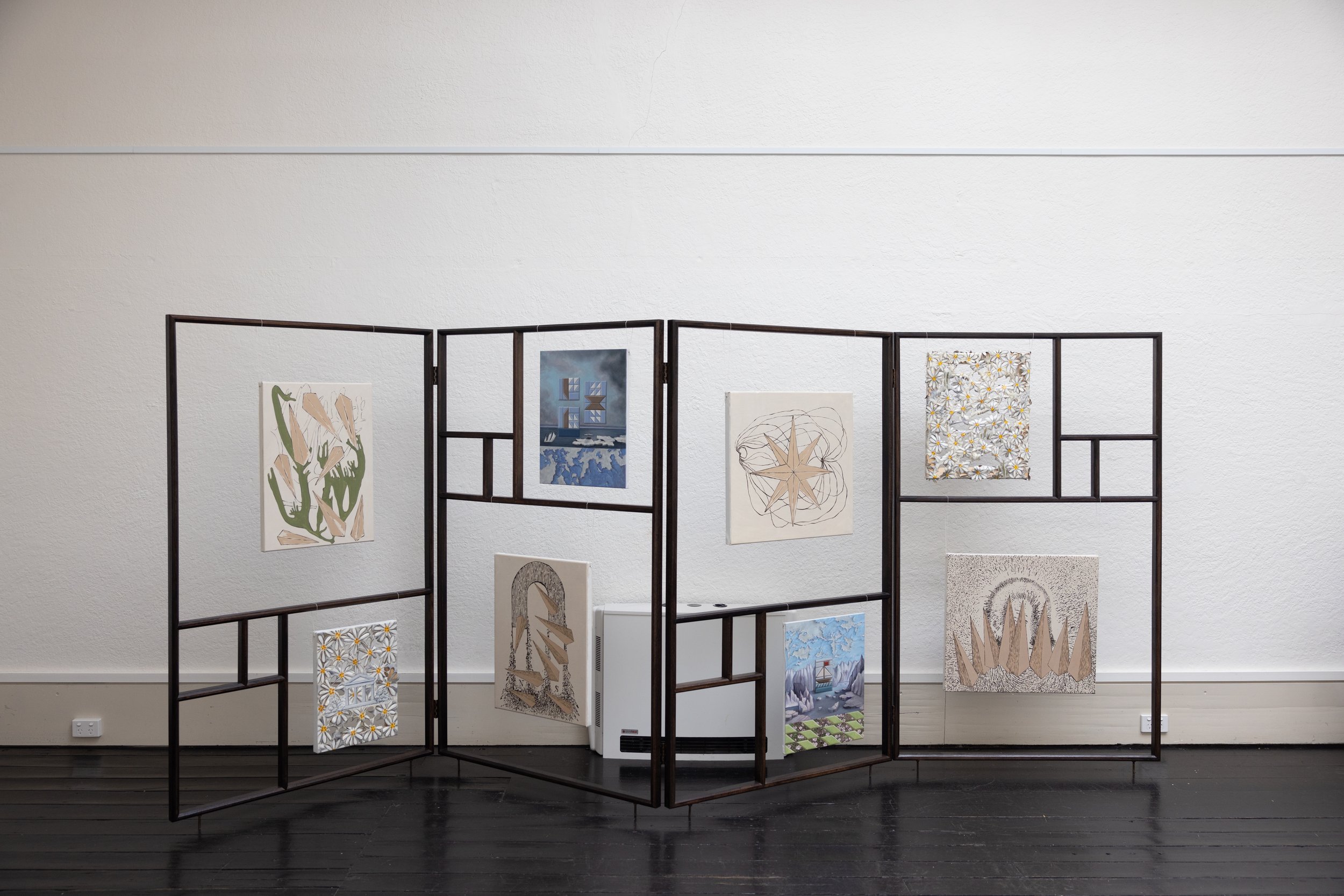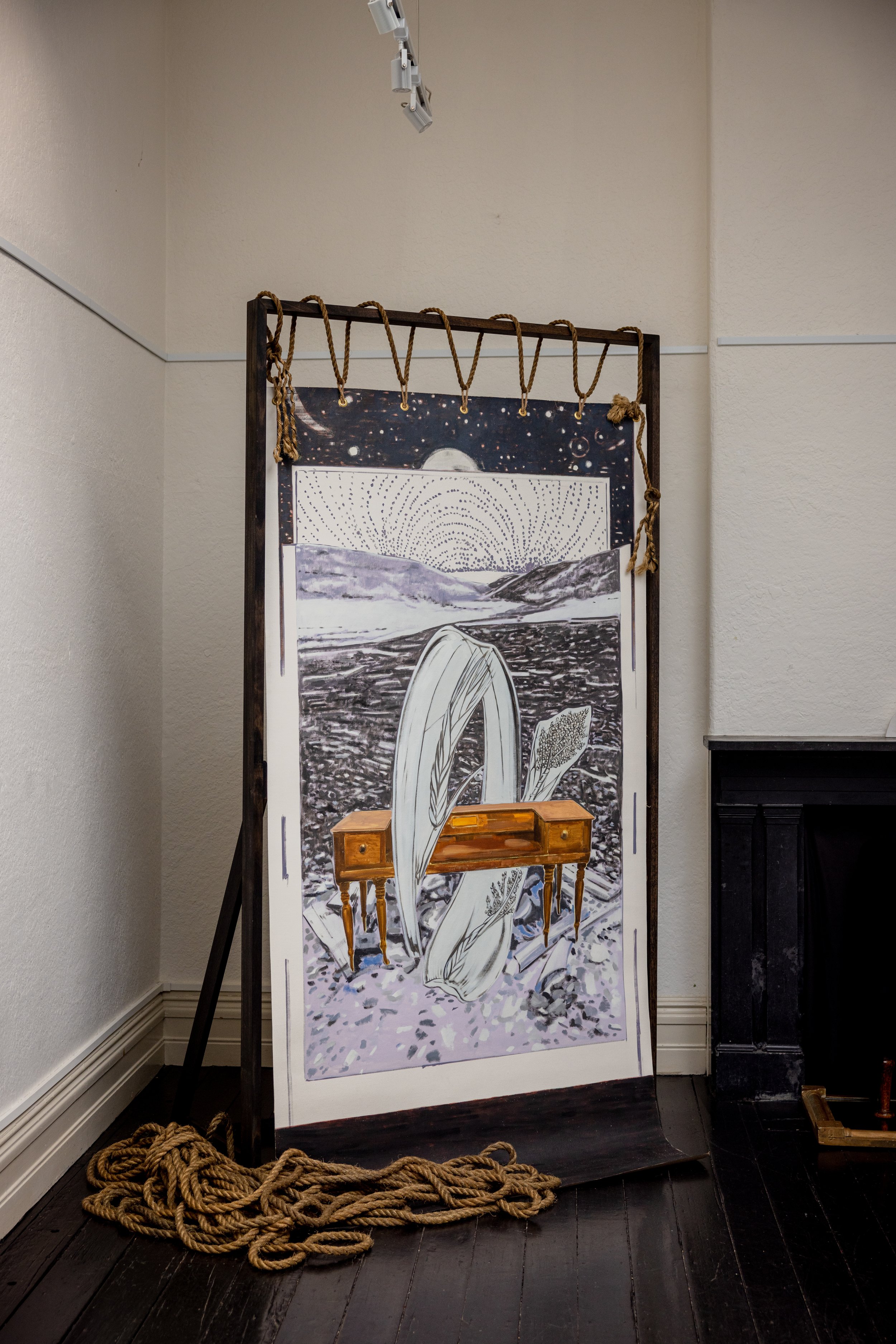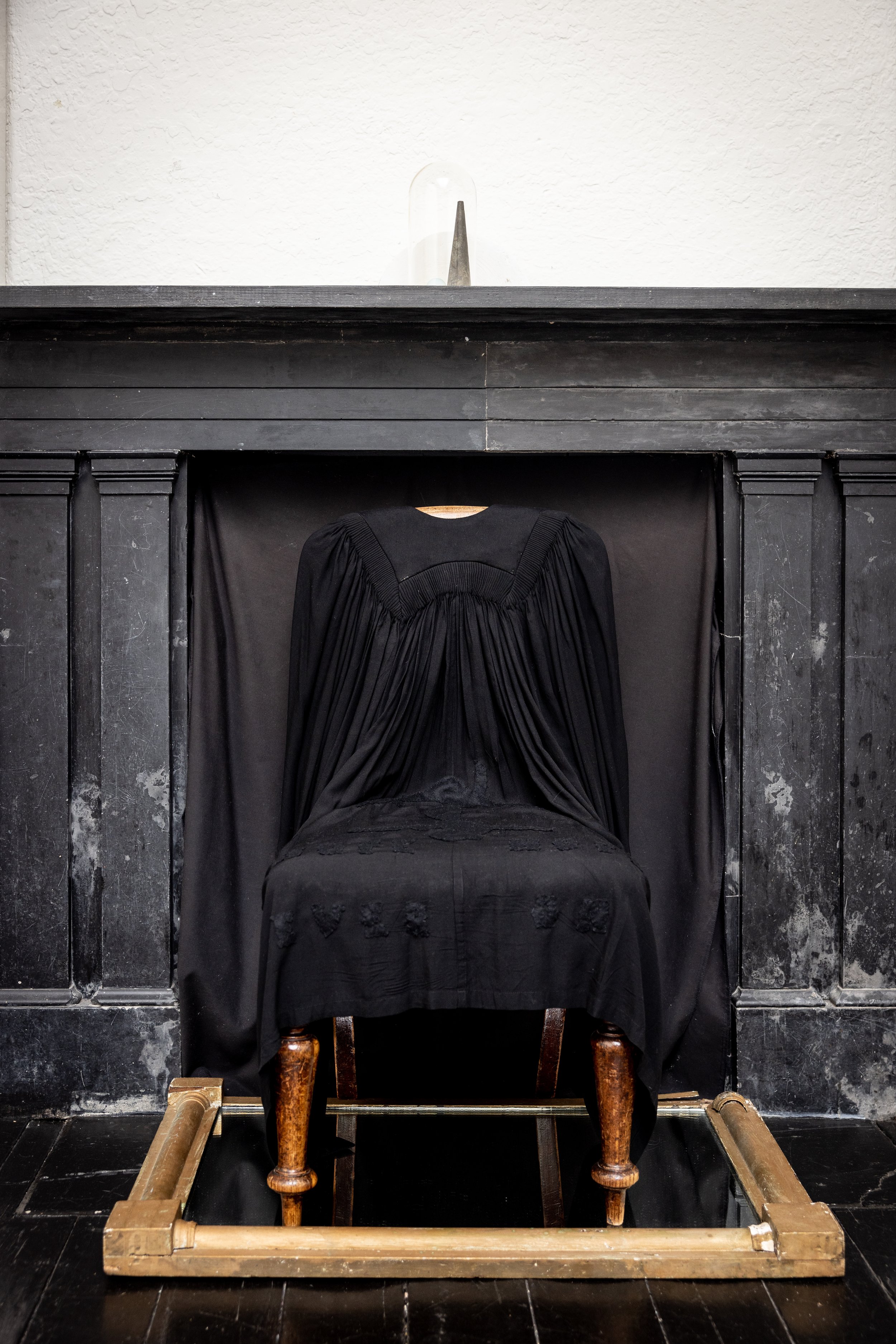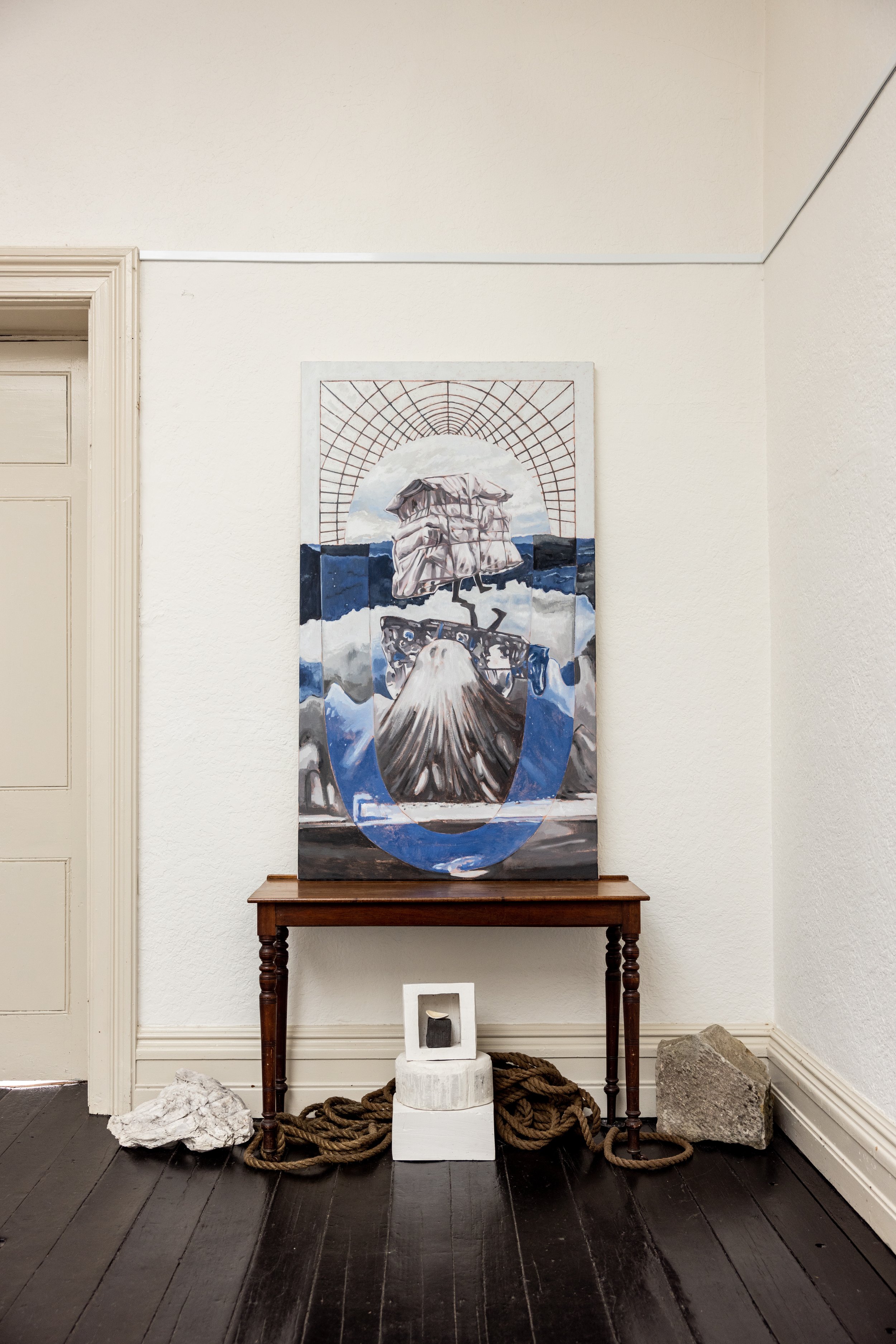f i g m e n t
Jo Chew + Amber Koroluk-Stephenson
Curated by Eliza Burke + Maria Kunda
Lady Franklin Gallery, Lenah Valley, lutruwita/Tasmania
3 - 25 June 2023
All difficulties, 2023, charred table, plaster, cloth, wheat, glass, found objects, dimensions variable
All difficulties, 2023, detail
All difficulties, 2023, detail
Golden Mean, 2023, paintings from left to right -
Jo Chew, Fathom, 2023, oil on linen, 61 x 46cm
Amber Koroluk-Stephenson, Flowers for Jane, after Thomas Bock and William Gould, 2023, oil on linen, 45.5 x 35cm
Jo Chew, Where they fall, 2023, oil on linen, 61 x 46cm
Amber Koroluk-Stephenson, Mirage, 2023, oil on linen, 50 x 40cm
Jo Chew, Whether there be prophecies, 2023, oil on linen, 56 x 61cm
Amber Koroluk-Stephenson, Garden’s edge, after William Gould, 2023, oil on linen, 50 x 40cm
Jo Chew, Much wanting, 2023, oil on linen, 56 x 61cm
Lodestar, 2023, oil on linen, dimensions variable
All mysteries and all knowledge, 2023, oil on linen, Tas oak stand, antique rope, 250 130cm
Foul anchor, 2023, antique chair, mirror, academic gown, cloth, embroidery thread, dimensions variable
Foul anchor, 2023, detail
Foul anchor, 2023, detail
Moving mountains, 2023, oil on canvas, table, rope, plaster, ceramic, charred wood, bone, quartz, sandstone, 152 x 86.5cm (painting dimensions
Moving mountains, 2023, detail
f i g m e n t
figment is a site-responsive exhibition engaging with archival materials and the neo-classical architecture of the Lady Franklin Gallery. Jo Chew and Amber Koroluk-Stephenson explore the entangled stories of Lady Jane and Sir John Franklin, interweaving themes of dislocation, grief and stasis that persist at the gallery, a curious example of lutruwita/Tasmania's colonial design sited at Ancanthe Park. Through an assemblage of paintings, collage, sculptures and speculative fictions, the artists unpick mythologised aspects of the Franklin’s history and consider elements of folly and delusion in the Franklins' aspirations. figment offers an opportunity to consider the shadow meanings of colonial presence in the landscape.
‘our little museum… not yet quite completed’
Written by Maria Kunda, June 2023
A Greek temple set on a grassy slope in the middle of a suburb, flanked by conventional houses, a bus stop, and public toilets; it is a curiosity.
The exhibition Figment came about because two artists, Amber Koruluk-Stephenson and Jo Chew, were drawn to the incongruity and quaintness of the building, and wanted to make works that would lend themselves to interpretation and might spark conversations about the colonial site and what it means today. The idea was to invoke the stories of Lady Jane and Sir John Franklin to create a mediation-in-place.
The building, now known as the Lady Franklin Gallery, was originally called Ancanthe Museum. Some know it well, but to many it’s a puzzle. I first saw it as a child, and to me the building has the air of having landed like an uncertain visitor, perched somewhat uncomfortably on the edge of a chair. It sits in an excavated indentation in the ground, dug-in, but not fully integrated within in its environs which are officially described as ‘remnant grass land’. The land when Lady Franklin purchased it was ‘likely covered by a grassy woodland dominated by Eucalyptus amygdalina (black peppermint).’ To my adult eye this sandstone building is on the land but is not really of it, reflecting something about the ongoing condition of the people who arrived on this island in the 1800s, and their ancestors who’ve ‘dug in’ over several generations, still contending with a violent history.
The home of the Tasmanian Art Society since 1948, today the Lady Franklin Gallery feels loved and cared for. It provides a pocket of tranquility with birdsong and babbling water. Inside, the building feels more like a converted chapel or nineteenth century school room. The interior is more familiar and domesticated than the outward classical appearance suggests. Altogether, inside and out, it seems decidedly too small to live up to the name of ‘museum’, even for the time in which it was built. Lady Jane Franklin herself referred to it as ‘our little museum’. So why, we might ask, was it so little? And, why was modelled after a Greek temple?
From Jane’s Franklin’s letters to her sister Mary Simpkinson, we gather that a neoclassical design was her plan from the start because in 1841, she asked her sister for ‘a pretty little design for a Glyptothek... I mean nothing more than 1, 2 or 3 rooms, of small size tho’ good proportions, to hold a small number of pictures, and a dozen of casts of the Elgin and Vatican marbles.’ Though the plan for the building was humble in scale, the parcel of land was very sizable, over 400 acres. From this I think we can deduce that the temple was intended as a focal architectural feature in large estate, envisaged as an expansive parkland.
In historical context, the ‘Greek Revival’ style was not at all an unusual choice. The style was common to a lot of public buildings of the era, and more particularly it was popular for the follies that were fashionable in Europe, particularly in English and French garden design in the eighteenth and nineteenth century. Some of the designs for follies were rustic, some oriental, some were sham ruins, others took the form of towers or turrets, and many of which took the forms of classical temples. Lady Jane Franklin’s folly, and I think we can comfortably call it that, seems to have taken the Greek revival style as a motif for establishing an ‘Athens of the South’ in Van Diemen’s Land.
*
The entry about Lady Jane Franklin in the Australian Dictionary of Biography, Volume 1, written in 1966 by Frances J. Woodward (author of an extended biography of Jane Franklin) presents a summary of Lady Jane, her ambitions and notes her museum of natural history, but with a twist in the tail.
A woman of idealism and great mental activity, she was determined to assist in the creation of an 'infant nation' (her friend Dr Arnold's phrase) rather than to play the traditionally passive role of governor's lady in a convict colony. In this aim she succeeded. Through her efforts Tasmania became the intellectual centre of the Australian colonies during Franklin's term of office. Under her influence he founded in 1839 the society which became in 1848 the first Royal Society for the advancement of science outside Britain. In 1839 Lady Franklin bought 130 acres (53 ha) of land near Hobart Town for a botanical garden, to which she gave the name Ancanthe. Here a museum of natural history was built for her, on the model of a Greek temple, and to it the collections she had been forming in Government House were removed. They and the accompanying library were dispersed in 1853, and the miniature temple became a storehouse for apples, the cultivation of which had been one of Lady Franklin's interests.
Jane Franklin’s archived letters indicate that her intent was for the building to be surrounded by botanic gardens of native flora. It’s interesting to note how Thomas Bock’s preliminary sketch for the engraving used in the invitation to the official opening of Ancanthe differs from the final version. In the early one, Bock embellished the design with European-looking trees flanking the temple, but in the design that was ultimately used, the trees are different, resembling the forms of native trees. But Lady Franklin’s plan for a native botanic garden did not come to pass. We can glean a little about what did happen on the site from the limited pictorial record in the archive.
According to the photographic record, at different points in the past the temple may have appeared stylistically integrated into its surroundings, though not in the manner in which Lady Jane intended. One old photograph shows a staircase leading up to the existing stone steps of the portico, more imposing than those there now. Another photograph seems to show vertical European trees, conifers perhaps, framing the building in a picturesque manner, against the majestic backdrop of the mountain. The archive offers a few brief accounts of the fate of the building. Already by 1871, according to Walch’s Tasmanian Guide of 1871 it was ‘dilapidated’ but, nonetheless, it's recommended as a popular if somewhat inconveniently distant pedestrian destination and picnic site.
A stereographic image from about the same time, by the local photographer Thomas J. Nevin, shows a group of people who have made the excursion, seated on the stone steps which look to be in disrepair. Walch’s Guide also recounts that by 1871 the contents of Lady Franklin’s museum had been rehoused in the Museum built in Macquarie Street. A photograph from 1923 shows that the ‘miniature temple’ was then tightly encircled by orchards, weatherboard homesteads and cottages, in a domesticated landscape demarcated with post-and rail fences. Far from depicting a classical folly in a large estate with botanic gardens, the picture rather looks as though an image of a temple has been incongruously collaged into a photograph of farmlands. Later, sometime before 1939, the building is photographed in a thoroughly inglorious state. By then, the museum and parklands were no longer privately owned, having been purchased by the Hobart City Council in 1921, but clearly it took the Council many years to work out what to do with Ancanthe. It’s fearsomely surrounded by tall weeds – gorse perhaps – and cordoned off from the road by a very crude, wobbly wire fence. There are high piles of something-or-other stashed on the portico: folded boxes perhaps, if it was still being used as a ‘storehouse for apples’? Or perhaps the stacks are building materials assembled for the repairs. In any case, it is far from an Arcadian idyll.
We see the resurrection of the little museum captured in moving pictures. The Tasmanian Amateur Cine Society Presents Re-opening ceremony of Lady Franklin Museum is a four-minute black and white silent film from 1949. The building has apparently been refurbished, and now the reduced grounds are bounded by solid post-war suburban-style concrete-rendered walls embellished with wrought iron struts. The occasion is presided over by the Governor of the day, Sir Hugh Binney and his wife Lady Binney. There are ladies in hats and gloves, numerous bouquets, and some frivolity too as some young ladies wearing some version of period costumes persevere with their bonnets while being buffeted by ferocious winds. It looks very small-town-respectable. The film marks the moment in which the Lady Franklin Gallery has been turned into a provincial municipal asset.
Not long after the reopening of the Lady Franklin Gallery, Frances Woodward’s Portrait of Jane: A Life of Lady Franklin was published in 1951. Several well-known writers have approached the stories of the Franklins since, and there has been a new wave of historicising and myth-making attached to their exploration and colonial endeavours.
Over last decade there has been yet more attention to the Franklins due to the remarkable discoveries in 2014 and 2016 of the wrecks of the two ships, the HMS Erebus and the HMS Terror, which set sail in 1845 bound on an Arctic exploration voyage led by Sir John Franklin, in his final and fatal voyage.
Sir John Franklin arrived in Van Diemen’s Land in 1837 to take up the post of the lieutenant-governorship, as successor to Colonel (Sir) George Arthur. He arrived as a celebrated Arctic explorer, with a wife who was reputedly erudite and cultivated. The Franklins left in 1843 under a cloud. In particular, John Franklin was systematically undermined and betrayed by the Colonial Secretary of Van Diemen's Land, John Montagu. Montagu maligned Sir John and Lady Franklin to the Colonial Office and mounted a viscous whispering campaign against the Franklins in Hobart. He accused Jane Franklin of ‘petticoat government’, in other words of having undue interference in public matters – improper for a lady. All this was fodder for a hostile press in Van Diemen’s Land. The conditions endured by the Franklins in the last stretch of Sir John’s term of office helps to explain why Lady Franklin’s vision for Ancanthe Park did not eventuate, and why she organised an official opening of the museum when, as she wrote, it was ‘not yet quite completed.’ The opening was one of her last engagements before leaving. Demoralised, but grateful to those who expressed support and affection, the Franklins returned to England to salvage their honour. Sir John resumed his purpose of Arctic exploration, which proved to be disastrous.
* *
In the interval of about a hundred and seventy years during which the Erebus and the Terror were lost in the deep, the history of the so-called ‘new world’ has sedimented. Stories once told as epic tales of valiant exploration and discovery are now thoroughly imbricated with greed and exploitation, corruption and violence. The discovery of the sunken vessels concluded the mystery and investigations that occupied Lady Jane Franklin from about 1847 nearly until her death in 1875. She tirelessly lobbied to make sure the fate of the men who’d become lost in the ice was known.
The most abject and grisly details of the failed quest were painstakingly pieced together over many decades. During numerous Arctic search expeditions in the years following the disappearance of the ships, written reports, artefacts and human remains were collected. These showed that many members of the expedition did not die quickly, but tortuously. Most distressing to Jane Franklin were reports from the Rae-Richardson Arctic expedition of 1854. Information was gathered from the Inuit, about the death of white sailors who’d resorted to cannibalism. Even though the Inuit were able to show many objects that had clearly belonged to Franklin and his crew, their testimonies about the condition of the white men and their remains were not believed. Lady Jane energetically refuted the idea that British Naval Officers could ever fall to such uncivilised depths as cannibalism, but now based on forensic evidence it is generally accepted that human bone remnants show typical signs of having been stripped of flesh and marrow for eating. =* *
In May 1859, a report called ‘Victory Point Note’ was found, which recorded that Sir John Franklin had died in June 1847.
* * *
The artworks for the exhibition came together via several speculations, visual enquiries and word plays (these became titles of the works). In conversations between the artists - Jo Chew and Amber Koruluk-Stephenson, and the curators – Eliza Burke and myself, we came to think about the temple at Ancanthe Park as a nodal place, where lines of enquiry intersect. For Jane Franklin, the inveterate traveller, the site appealed because it was in the hinterland of Hobart Town, a gateway between the tamed territory of the township and the wilds. Perhaps she saw the country beyond it as untameable but explorable. Her vision was undoubtably a type of aesthetic mapping and delineating exercise, not so very different perhaps, to the arctic explorations of her husband. The neoclassical touch was calculated to be an ideological lodestone that symbolically links this site to Europe.
An underlying theme of the exhibition is magnetism, considered literally and metaphorically, which runs through all the artworks. The painted canvas portion of Jo Chew’s Moving mountains was undertaken first and was a talking point for us all, which led to other musings. The canvas incorporates a visual trope, a magnet, a ‘U’ shape, that repeats elsewhere in the works, sometimes by chance. The ‘U’ shows up in the droop of the academic gown in Foul anchor; again in the slump of Folly. Moving mountains speaks of voyaging, communication across vast distances, cold, discomfort, also confusion, bravado and haplessness.
The subject of magnetism was a kind of mania in the Victorian era, referred to as the Magnetic Crusade. It preoccupied the Admiralty, the British Association for the Advancement of Science, and the Royal Society. As well as searching for the Northwest Passage, a key objective of the lost Franklin expedition was to make observations using geomagnetic instruments, to better understand the Earth’s magnetism and to see if recording magnetic data could improve compass readings. Ironically of course, it was a bid to improve navigation that proved to be a catastrophically unsuccessful example of mis-navigation.
Jo and Amber collected visual reference materials that relate to the Earth’s magnetic field, geomagnetic poles and navigation, objects and phenomena which influence, and are influenced by, magnetic fields: for example, aurorae (which are provoked by magnetic storms). Lodestar the collaborative floor work is in the form of a large compass rose. It is comprised of sections of oil on canvas completed by both artists. Koruluk-Stephenson painted the pale sections that bear cloud like forms, and Chew made the dark sections that depict floral elements. The sections have been pieced together patchwork style, and the patchwork motif carries through in Amber Koroluk-Stephenson’s two paintings, Mirage, and Endeavour. The motif has a narrative link to a famous quilt, the Rajah Quilt, now held by the National Gallery of Australia which was created by women convicts being transported from Woolwich to Hobart on the ship the Rajah in 1841 and presented to Lady Franklin. The materials were organised by the British Ladies Society for promoting the reformation of female prisoners convict ship sub-committee, supported by both Lady Franklin and Elisabeth Fry, the celebrated English social reformer with whom Jane Franklin exchanged letters.
The compass rose points reappear as dismembered triangular elements in four of Jo Chew’s works Fathom, Where they fall, Much wanting, and Whether there be prophecies, and these hang in relation to Mirage, and Endeavour, on the screen-like stand. In Chew’s work, themes of disorientation, perishing and mourning relate to Jane Franklin’s acute desperation to learn what had become of her husband. Before she had confirmation of his demise, in her desperation and in spite of a personality that seemed eminently hardnosed and rational, Jane resorting to communicating with an Irish a shipbuilder named William Coppin, who claimed that his family received messages from beyond the grave from his daughter Louisa, and he offered to ask the ghost to assist in the search. In time Jane learned of Sir John’s certain death, but far from playing the part of a retiring, defeated widow, she remained fixed on finding what had befallen her husband and his men, and defending their honour.
Chew’s three freestanding works, All mysteries and all knowledge, Foul anchor, and All difficulties are each mournful works, so not without sentiment – but also not without judgement. The stitched phrase, My dearest Love, which appears mirrored in Foul anchor, is the salutation that Jane Franklin used to begin her letters to her husband. The assemblage encapsulates her erudition, her wifely devotion, her loss, and her exceptionalism and privilege. The legs of the Victorian chair in Foul anchor are oddly anthropomorphised to become those of an old woman, and the academic gown shifts into widow’s weeds. All difficulties, principally uses a ‘found’ side table of a vintage that suggests a time beyond Jane Franklin’s life span. It’s diminutive and feminised, scorched and humbled. I think this little work stands in for all manner of dark ideas that the swirl around the exhibition, that adhere to the Franklin’s story and the time the lived: ideas about women, about children, about blackness, about deprivation, about neglect, degradation, and cruelty.
Koruluk-Stephenson recalls two convict artists to us Thomas Bock (c.1790–1855) and William Gould (1801–1853), both of whom created signal observations and representations of the colony which are important contributions to the historical record, but also reveal distortions of European perspective. A refrain that appears four times in the exhibition is Bock’s iconic image, the engraving of the Ancanthe museum for the opening invitation. In terms of their pictorialism, Koruluk-Stephenson’s works invite reflection on the colonising project. For the most part, they engage whimsically with the traditions of landscape painting and the idea of the antipodean picturesque. There are some delicious passages of paint: sky and cloud, lively illusionism, and dynamic colour play. Yet, the works push past pictorialism, trompe l’oeil, and surface into a register of theatricality. They defy us to look through them and past them. Whimsy gives way to grimmer and graver emotions.
Garden’s edge, after William Gould, operates at one level as a memento mori. The flowers, emulating some of Gould’s are waxy and funereal. Gould, producer of exquisite Vandemonian art works and recognised in his own day as an artist of stature was a repeat offender and an alcoholic. He remained a miscreant after he was granted his certificate of freedom from Port Arthur in 1835. Unredeemed, he died poverty-stricken. Thomas Bock by contrast seems to have led an enjoyable life in the colony, rubbing shoulders with the upper echelons of the society. He was transported to Van Dieman's Land for assisting in an abortion, specifically charged with ‘administering concoctions of certain herbs to Ann Yates, with the intent to cause a miscarriage.’ At the time he was married and the father of five; Yates, a younger woman who some say he’d seduced. Bock was found guilty and sentenced to transportation for 14 years, however having served his sentence he remained in Hobart, where he seems to have created a profitable and quite celebrated life as a portrait painter and later photographer.
Bock is renowned for the series of portraits he made from 1823-35 for George Augustus Robinson (1791-1866), of fourteen Tasmanian Aboriginal members of Robinson’s missionary party during the period. He also painted the well-known portrait of the young Aboriginal girl, Mathinna (1835–1852), who was part of the Franklin’s household, but who they left behind at the Queen’s Orphan School in Hobart, when the Franklin’s were recalled to England.
The work titled Folly sags. Simultaneously the inverted form of the temple takes the shape of a big sling shot and a pelt: it’s aggressor and slaughtered prey. The cut-out temple form performs the calling out a lie about the ‘civilised’ or civilising mission of a penal settlement and reminds me of the title and the thesis of a crucial book, The Lie of the Land by Paul Carter. In that book, ‘the notion of landscape [stands accused of being] a deceitful or partial view, a scenic image which conceals uncomfortable truths or projects the interests of a powerful elite.’ This exhibition prompted me to revisit the book, written twenty-seven years ago. My impression is that in some ways it has yet to come of its time. The works in this exhibition are far from polemical or politicised, but they should cause us to take pause and to make us observe our environment carefully, to read the land for what has happened here, who has suffered and who has benefitted. Lady Jane Franklin has bestowed upon us a place to reflect on past, present and future.
References
Alexander, Alison (2016) The Ambitions of Jane Franklin, Victorian lady adventurer.
The Art Society of Tasmania. ‘History of the Lady Franklin Gallery’.
Hobart City Council "ANCANTHE PARK MASTER PLAN" (PDF). Inspiring Place. 1 March 2015.
Hobart City Council (2015) Ancanthe Park final reporthttps://www.hobartcity.com.au/files/assets/public/projects/150313_ancanthe_park_mp_final_report-resize.pdf
"Permanent and Provisional Registrations as at 22 Jan 2021" (PDF). Tasmanian Heritage Register. Archived from the original (PDF) on 24 September 2022. Retrieved 22 August 2022.
Carter, Paul (1996) The Lie of the Land.
Fitzpatrick, Kathleen (1949) Sir John Franklin in Tasmania 1837-1843.
Flanagan, Richard (2008) Wanting.
McGoogan, Ken (2005) Lady Franklin's Revenge.
Mounster, Bruce (4 August 2014). "Hobart historian and author Alison Alexander wins $25,000 National Biography Award for 'engrossing' work on Lady Jane Franklin". The Mercury, Hobart.
Rääbus, Carol (17 October 2017). "Lady Franklin Gallery: Why there's a Greek-style building at the back of Lenah Valley". abc.net.au.
Sheridan, Gwenda (8 January 2012). "Ancanthe… all that will be lost". Tasmanian Times.
The Tasmanian Amateur Cine Society Presents Re-opening ceremony of Lady Franklin Museum (1949) Tasmanian Archives: Reference: NS6350/1/22.
Watson, Paul (2017) Ice Ghosts: The Epic Hunt for the Lost Franklin Expedition.
Woodward, Frances J. (1951) Portrait of Jane: A Life of Lady Franklin.
Woodward, Frances J. (1966) ‘Franklin, Lady Jane (1791–1875)’, Australian Dictionary of Biography, National Centre of Biography.
This project was assisted through Arts Tasmania by the Minister for the Arts.
It has been kindly supported by The Art Society of Tasmania and Lady Franklin Gallery.
A special thanks to:
Ben Grieve-Johnson of Other Furniture; David Greenhalgh; Fernando do Campo; Jane Stewart; Chris Phelps; Nikki Munro; Jane Battaglene; Alison Alexander; Malcolm Johnson; Chris Undy; Claire Sheppard; Nicholas Randall; Rob Power; Molly and Ezekiel Chew; Mary Lijnzaad; Caitlin Sutton; Elizabeth Brown; Christoff Kartzoff; Ali Sawyer; Neil Haddon; Walter Knoop
Installation photographs by Rosie Hastie
Publications and media by Chris Phelps
